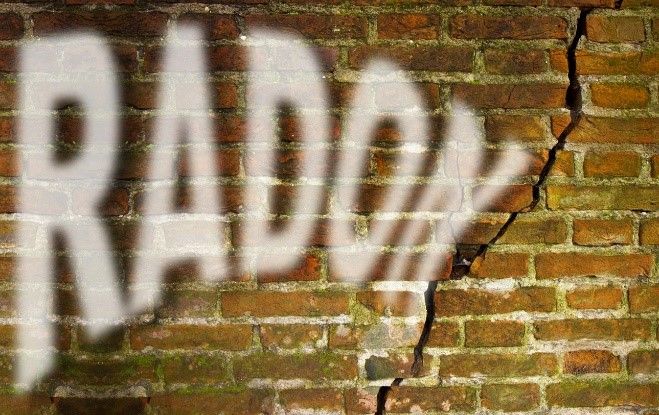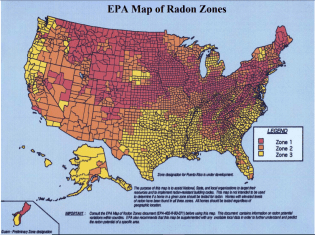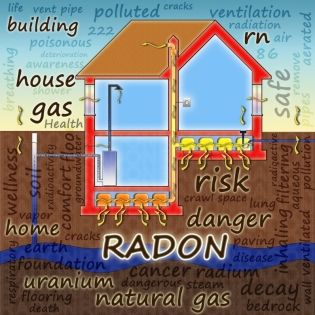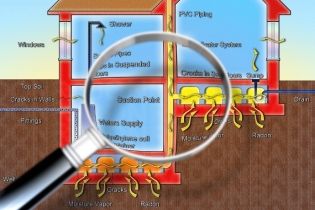What is Radon?
Radon is a silent killer: you can’t see it, smell it, or taste it.
People experience no symptoms until, after prolonged exposure, they develop lung cancer. Radon is the leading cause of lung cancer for non-smokers and the second leading cause of lung cancer for the general population.
Contact RPF Environmental, Inc. for a consultation on radon testing in your building.
www.airpf.com 1-800-SAFEAIR
An elevated exposure level to radon is easy to find and simple to fix.
Radon test kits are inexpensive, reliable, and straight forward to use. Qualified Radon testing companies can also test for little time and effort. For multi-family housing and larger buildings, only a qualified professional should be used for testing.
Where does radon occur?
Radon occurs naturally in areas throughout the United States. It is an invisible gas and it results from the natural decay of uranium that resides in soil and rock. Radon travels to the Earth’s surface and into buildings through cracks and holes in the foundation; even in well-sealed and new buildings. As radon particles break down, small bursts of radiation are released. Since the particles are in the air people breathe, the radiation can occur in the lungs and cause tissue damage. In some buildings, in some locations, radon particles can become trapped and build up indoors. After long periods of exposure to elevated levels of radon, lung cancer can develop. Not everyone who breathes radon will get cancer; factors such as the level of radon, the length of exposure, and whether a person smokes are at play. Smokers are at a much higher level of risk than non-smokers.
Radon in the home is a concern because that is where people spend most of their lives. However, buildings such as work places, schools, health care facilities, and multi-family complexes are also important for consideration.
How Does Radon Get into Buildings?
Radon has been found in every state in the United States. The EPA has interactive maps of the United States showing where higher levels of radon can occur. The image below is one example. Do not think of as these maps as a guideline for whether testing should occur. While there are some areas that have more radon than others, unsafe levels can still occur in regions where the expected overall radon level is low.
Here are some ways that radon can enter your home:
- Cracks in solid floors
- Construction joints
- Cracks in walls
- Gaps in suspended floors
- Gaps around service pipes
- Cavities inside walls
- The water supply
Radon moves up from the ground into buildings.
Like any gas, radon can enter buildings through the smallest of spaces. It travels from the ground into buildings through openings in floors or walls that are in contact with the ground. The air pressure inside is usually lower than that in the ground below the foundation, and so air containing radon is pulled into the building. From there it can accumulate indoors over time, posing a health hazard. Any building can have high levels of radon, including new and old, well-sealed and drafty, and buildings with or without basements. Radon can enter a building through well water, however this is a minor source compared to what comes through the foundation, and it is usually only an issue in drilled bedrock, or artesian, wells.
About 2,900 of those occur among people who have never smoked.
Radon Testing Considerations
- Testing is the only way to know the level of radon in a building. Levels of radon can vary radically from building to building; it depends on the construction and the amount of radon in the soil. Even newer buildings, including those with radon resistant construction, are recommended to be tested by the EPA.
- The EPA recommends acting to reduce radon in buildings where the level is 4 pCi/L or higher. Radon is measured in picocuries per liter of air or pCi/L. The higher the pCi/L, the greater the risk for health issues. EPA studies found that radon concentrations in outdoor air average about 0.4 pCi/L. However, radon and its decay products can accumulate to much higher concentrations inside a building.
- In most states, people can perform tests on their own for single family. Test kits can be purchased at such places as hardware stores, online, or from state agencies. Be sure to select a test that is labeled to meet EPA requirements. It is important to follow directions exactly. The test kit should be placed in the lowest and most often inhabited area of the building; the basement or first floor. Since radon emanates from the ground, it is unlikely that radon will accumulate to dangerous levels after the second level. Avoid enclosed areas, high humidity, or high air velocity, such as a kitchen, bathroom, laundry room, furnace room, closet, or crawl space. Keep windows and doors closed as much as possible to avoid drafts. The kit, once used, is usually mailed to a laboratory to obtain test results. A state or local radon official can help you if you have any questions. For multi-unit housing and larger buildings, it is recommended that a qualified professional be used to complete radon testing.
 How to Reduce Indoor Radon
How to Reduce Indoor Radon
If your radon level is confirmed to be 4 picocuries per liter (pCi/L) or higher, fix the building. Choose a qualified radon mitigation contractor to fix your home because specific skills and technical knowledge are required. Many states require radon professionals to be qualified. In most buildings, the cost to lower radon to safe levels is the same as other common repairs. Costs will vary depending on the design of the building and the radon reduction method being used. The good news is that radon reduction systems work and hundreds of thousands of buildings have already been successfully modified.
About radon reduction systems
The system that is right for your building depends on your initial radon level, the costs of installation and system operation, your building size, and your foundation type. Most types result in loss of heated or cooled air and this may affect your utility bill slightly.
There are many variations of radon reduction systems. Often, radon is sucked from below a building and vented to the outdoors when it is quickly diluted. This usually involves piping and may involve ventilation with a fan. The type of building foundation is a major factor in how the system would be set up.
Sealing cracks and other openings may be required to make the system more efficient and help reduce the loss of heated or cooled air.
Building or room pressurization uses a fan to blow air in, from other rooms or from outdoors; the increases pressure prevents radon from entering. Since this option can affect energy costs, it is usually a last resort.
A heat recovery ventilator, also known as an air-to-air heat exchanger, increases ventilation by introducing outdoor air while using the heated or cooled air being exhausted to warm or cool the incoming air. Again, there would be increased energy cost, but not as much as without the temperature recovery of exhausted air.
Natural ventilation occurs by opening windows, doors, or vents to mix outdoor with indoor air and thus reduce radon concentrations. As soon as these are closed, the radon concentration will return to previous levels within about 12 hours. It should be considered a temporary solution due heating and cooling costs and security concerns.
Check the EPA Radon website for more information on these systems and how to choose a contractor. Also check with your state for information on licensure of remediation contractors.
 Hiring a Consultant to Test for Radon
Hiring a Consultant to Test for Radon
In many cases, building owners will decide to hire a qualified radon tester who knows the proper conditions, test devices, and guidelines for obtaining a reliable radon test result. The consultant should have proper professional liability insurance, and in some states, they require licensing.
Qualified radon testers can:
- Evaluate the building and recommend a testing approach designed to obtain reliable results
- Explain how proper conditions can be maintained during the radon test
- Emphasize to occupants that a reliable test result depends upon their cooperation since interference with, or disturbance of, the test or closed-building conditions will invalidate the test result
- Analyze the data and report the measurement results
- Provide an independent test result
www.airpf.com 1-800-SAFEAIR



 How to Reduce Indoor Radon
How to Reduce Indoor Radon Hiring a Consultant to Test for Radon
Hiring a Consultant to Test for Radon

